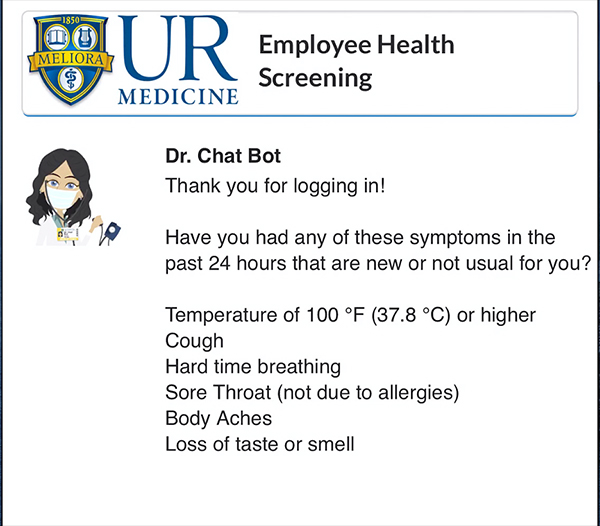When the pandemic finally reached Rochester in March, anxious citizens deluged a COVID-19 hotline at the University of Rochester’s Medical Center, tying up emergency room and Urgent Care physicians and staff. Medical Center leaders needed a way to screen out the calls from the “worried well,” so people with actual symptoms could get through. Pronto.
They turned to the UR Health Lab.

In two days, the team produced a chatbot—a software application to conduct an online chat conversation via text or text-to-speech, in lieu of direct contact with a live human. Within a week the app—dubbed Dr. Chat Bot—reduced the hotline’s volume of calls by 50 percent.
When New York ordered statewide lock downs a week later, the Medical Center’s Employee Health office struggled to conduct daily screening for the 9,000 essential employees who still needed to report for work.
The UR Health Team again delivered, revamping Dr. Chat Bot not only to automate the office’s paper and pencil screening, but also to link the information to other, previously separate databases so the University could better track the health of its employees.
And now, a third iteration of the COVID-19-tracking chatbot technology is gaining national attention. It will be used to track the pandemic across 13 counties in the Rochester region, giving policymakers better guidance on when and where to reopen by pinpointing how the disease is progressing in individual zip code areas. (Read more here.)
Monroe County executive Adam Bello says the regionwide ROC Covid-19 tracking project is a “game changer.” And Monroe County Health Director Michael Mendoza praised Health Lab codirector Michael Hasselberg and other lab members for their vision in creating a tool “that stands to make an immeasurable contribution to public health in our region.”
Sign up for ROC Covid-19
To learn more about ROC Covid-19 and how to participate, go to Roccovid.org.
Coronavirus update
The University’s website is a way to find guidance and critical information during a rapidly changing situation.
What is the UR Health Lab?
Part think tank, part digital health technology incubator, the lab is an “innovation shop that is very different from anything else at the University,” says Hasselberg, an associate professor of psychiatry and clinical nursing.
Small, but nimble, the lab uses the project management approach of “scrum” to quickly meet technology challenges identified by Medical Center leaders. The framework sets fixed time periods, called sprints, for team members to complete a set amount of work; members meet in daily “scrums” to track progress.
The lab, directed by David Mitten, professor of orthopaedics, is especially strong in machine learning and mobile application development.
Developing the chatbot and its mobile applications was a relatively straightforward task for the lab members involved in that part of the project. They included Mitten; Hasselberg; Daniel Hudy and Michael Curtis, senior software engineers; Kathleen Fear, senior data analyst; Jack Teitel, lead data scientist, and Cristiano Tapparello, research assistant professor in electrical and computer engineering and Health Lab director of software engineering.
The “biggest lift” for the team, Hasselberg says, was integrating the various databases for the “back end” of version two of Dr. Chatbot, used to screen Medical Center employees.
“If you are an employee of the University and you log into the chatbot, we have to authenticate you and make sure that you are who you say you are,” Hasselberg says. “And if, god forbid, you have symptoms, we need your information to go back to the right people at Employee Health Services, so they have enough data to help you.”
All of that involved connecting different datasets, which has been problematic in the past because of the decentralized structure of the University. “Data at the University are very dispersed,” Hasselberg says, “so actually this has moved our University forward in addressing that problem. We now have a head start on merging our data together, and making it interact with each other appropriately.”
Read more
University makes technology for tracing COVID-19 symptoms available as open source code
Chatbot helps managers make sure it is safe for employees to report to work.
Novel project uses University technology to track COVID-19
Online questionnaire asks citizens to voluntarily report symptoms, providing important information that may allow policymakers to address outbreaks by zip code.
Dr. Chat Bot COVID-19 screenings go University-wide
An online tool to screen for COVID-19 symptoms before employees report to work is being phased in University-wide.
For Tapparello, the “front end” designer—as for other members of the lab—the project meant “no Fridays, no Saturdays, and no Sundays” as they worked nonstop to get the first two iterations of Dr. Chat Bot launched.
“And I was still teaching a class and trying to move forward on an NIH grant that I am the principal investigator for,” Tapparello says.
Then he had to rewrite the entire interface for the regional ROC Covid-19 tracking project.
“What you see now on the ROC Covid website was completely redesigned from scratch,” he says.
But Tapparello wouldn’t have it any other way.
“Just seeing the application on the ROC Covid website, and how it is reaching so many people, is just fantastic. It makes up for all the time you spend working on it.”




